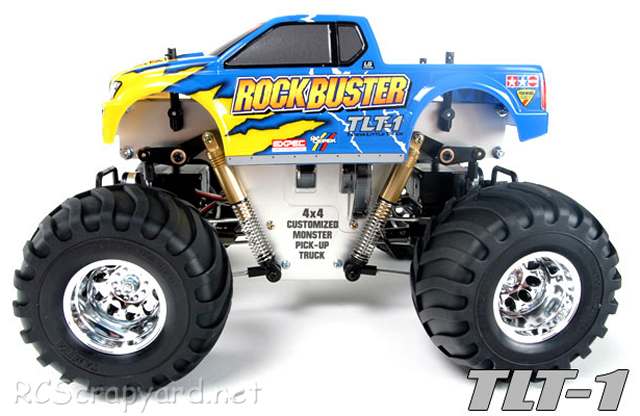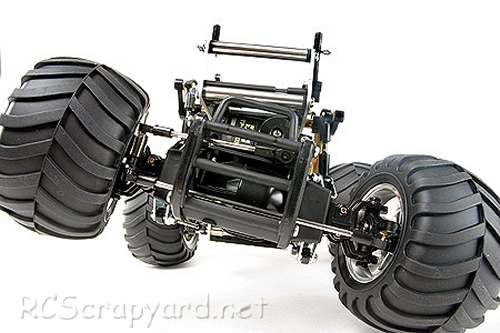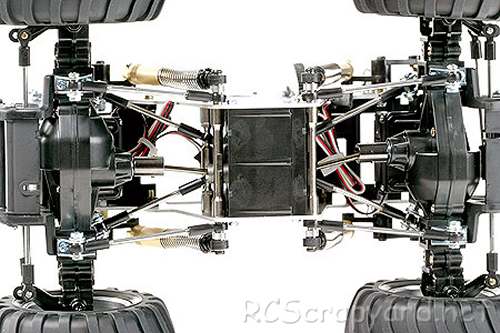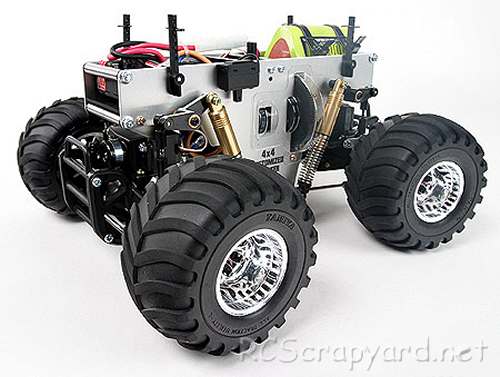

|


|
Tamiya TLT-1 Rock Buster RTR - 23635
|
Released by Tamiya on August 23, 2006, the 4WD TLT-1 (Tamiya Little Truck) Online Limited Sales Series Rock Buster (# 23635) Factory Finished, Limited Edition, was designed to use 540 electric motors and standard size ESC, Servos and radio system. The original basic Rock Buster kit (#47201) had been introduced in 2003 and a Rock Buster Combo (#47201c) was also available.

The shaft/belt driven model is based on a vertical alloy plate chassis, with gear type differentials, a central ball differential, coil spring over oil filled dampers, dogbone drive-shafts and bushings.
Like most Tamiya kits the model comes with plastic and sintered metal bushings, that after a short while, when dust and grit get into them, can actually wear into the metal drive shafts that spin in them. If your model is for racing seriously, these should be replaced by a full set of steel shielded ball bearings.
To get the best from the Tamiya TLT-1 Rock Buster, it needs to be fine tuned to handle jumps under control and has enough grip to hug the corners at high speed, without slipping off the track. Small adjustments can make a Big difference and our simple to understand, step by step procedure, will guide you to the best Set-up for your driving style.








|
|
|

|



Buying a Used TLT-1 Rock Buster Rock Crawler (and What to look for)
Make a General Visual Inspection
Check the Body-Shell
If the body shell of your Rock Crawler is broken, ripped or damaged in any way, this can be easily repaired with rubber solution glue. Also, for added protection and if available for your model, fit an under guard to stop dirt and gravel entering the chassis. Drive Shafts and Turnbuckles
Examine the Drive System
The gearbox of your used Rock Crawler should be opened up to check for damaged gears and wear. If there is excessive backlash in the gearing, these should be replaced. A thin coat of grease on the gears is enough to allow smooth operation and reduce further wear. Pinions and Spur Gears
Steering Servo and Servo-Saver
Don't Forget those Bearings
|









|






|
|
|
|
Hints, Tips and Information
Gearing to Win
Just because you have the latest model, the best available batteries, the most powerful electric motor or nitro engine, doesn't mean you will go out and win everything in sight. The fastest car on the track is rarely the one that wins, it's the one that can accelerate out of corners under control, and remains consistent and efficient from the start to the end of a race.
|
|
Hints, Tips and Information
Tire Compounds
Way back in the early 1990s when I first got into RC, most of the off-road models available came with chunky hard compound block tires that gave little or no grip on grass or dirt tracks. On-road didn't have this problem as they were still using sponge tires that with a coating of wintergreen based tire additive before each race to improve grip. There was even one guy who swore, before every race, he dipped his wheels in a glass of light ale. |
|
RC Models:
|
Radio & Motors: |
Other
Accessories: |